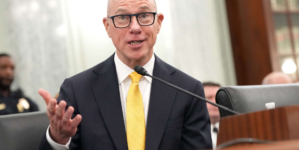-
Israel kills dozens in Gaza amid growing famine fueled by restricted aid flow - 18 mins ago
-
LIV Golf UK: Joaquin Niemann, Torque GC Take Control in Round 2 - 23 mins ago
-
ICE holding Tunisian man without proper medical help, family says - 30 mins ago
-
Where Could LeBron James Go Next? Top Landing Spots If He Leaves Lakers - 35 mins ago
-
AI data centers driving electricity bills up by 20% across 13 states - 45 mins ago
-
Colorado HC Deion Sanders Provides Health Update: ‘Back and Feeling Great!’ - about 1 hour ago
-
DraftKings Promo Code: Claim $150 Bonus For Dodgers-Red Sox, MLB, WNBA - about 1 hour ago
-
Kyffin Simpson takes Will Buxton around Laguna Seca before Grand Prix of Monterey - 2 hours ago
-
Emotional Kimi Antonelli Opens Up About Confidence Struggles At Belgian GP - 2 hours ago
-
Jessica Alba shows off bikini body in Mexico months after divorce - 2 hours ago
Social Security: Young Americans May Lose $110,000 to Keep Program Afloat
Social Security, a foundational program for U.S. retirees and disabled Americans, has come under renewed scrutiny as funding shortfalls loom.
A new report by the Cato Institute warned that today’s young workers might lose up to $110,000 in lifetime earnings to keep the program afloat.
Why It Matters
With the Social Security Trust Fund projected to reach insolvency in the next decade, younger workers now face the possibility of significant financial sacrifices to maintain the system for current and future beneficiaries.
More than 60 million Americans receive benefits every month. And according to Justice in Aging, Social Security lifts more than 22 million people out of poverty, including over 16 million older adults and almost 1 million children.
Robert Daemmrich Photography Inc/Corbis via Getty Images
What To Know
Social Security faces a potential crisis as its trust fund is predicted to be depleted by the mid-2030s, according to recent projections.
The primary driver is an aging population, particularly as Baby Boomers retire and a shrinking base of younger workers are paying into the program. As a result, the Social Security Administration would only be able to pay about 80 percent of scheduled benefits unless funding solutions are enacted.
The Cato Institute reported that keeping Social Security solvent in its current form would require today’s young workers—those just entering the labor market—to contribute significantly more over the course of their careers.
If changes are not made, these workers could see a reduction equivalent to $110,000 of their lifetime earnings due to higher taxes and/or reduced benefits, according to the Cato Institute.
That figure is based on the latest report from the Social Security Trustees, which said Congress would need to hike the payroll tax rate immediately and permanently by 3.65 percentage points, from 12.4 to 16.05 percent, to close the program’s $25 trillion funding gap and continue to send out scheduled payments.
“That means less discretionary income in each paycheck, which could have ripple effects on their day-to-day finances and long-term savings,” Kevin Thompson, the CEO of 9i Capital Group and the host of the 9 innings podcast, told Newsweek. “A tax increase would be a hit to growth as less discretionary spending means less in corporate earnings.”
According to the Cato Institute, this cut would be equivalent to giving up 20 months of pay at the worker’s average monthly wage.
“There are endless variables affecting Social Security, but in the end, the math does not lie,” Drew Powers, the founder of Illinois-based Powers Financial Group, told Newsweek. “To keep the program going, there will be adjustments in the current payroll taxes, income caps, and full retirement age. We could see a return of the Retirement Earnings Test and may even see means testing for the highest income retirees.”
This could cause outrage across the general public, which has generally favored targeting higher earners rather than taking away from future retirees’ payments.
A University of Maryland Program for Public Consultation survey showed that 53 percent of American adults considered it acceptable to reduce Social Security benefits exclusively for the Top 40 percent of income earners. This targeted reduction would address approximately 23 percent of the program’s projected funding shortfall.
There was also bipartisan support for raising the retirement age, which could close an additional 15 percent of the funding gap.
What People Are Saying
Drew Powers, the founder of Illinois-based Powers Financial Group, told Newsweek: “Younger workers, especially the youngest of the Millennials and all of Gen Z and beyond, should expect Social Security to look different for them than it does now. Adjustments to Social Security are rarely popular, but in the past Congress has been willing to act in the face of dire circumstances, such as in 1983 when the Full Retirement Age was extended.”
Kevin Thompson, the CEO of 9i Capital Group and the host of the 9 innings podcast, told Newsweek: “While such an increase would extend the solvency of Social Security by about 75 years, it’s not a complete solution. The real fix would likely require both raising the payroll tax and removing the income cap. But let’s be honest—that kind of proposal is a tough sell politically. Running on a platform to raise taxes rarely gains traction, even when it’s tied to securing the future of Social Security.”
Alex Beene, a financial literacy instructor for the University of Tennessee at Martin, told Newsweek: “There’s been an assumption made by Americans for decades now, and that is regardless of warnings and political posturing, Social Security will always be there to provide for retirees. The reality is there’s a tremendous shortfall coming in the next decade, and if Congress doesn’t act, beneficiaries will see their monthly payments dramatically reduced.”
What Happens Next
With Social Security’s financial future uncertain, Congress and the public are set to debate possible reforms, including benefit reductions for higher earners, payroll tax increases, and changes to the retirement age. The conversation will likely intensify as insolvency draws nearer in the next decade, with any enacted policy changes affecting both current retirees and younger generations entering the workforce.
No official policy changes have yet been passed, but the heightened awareness and survey support for targeted reform suggest continued bipartisan attention to the problem in upcoming legislative sessions.
“There are obviously different solutions to the shortfall that don’t involve raising that percentage, but it does present a grim prediction for the American workforce if Congress doesn’t act on a more efficient solution,” Beene said.
Source link































